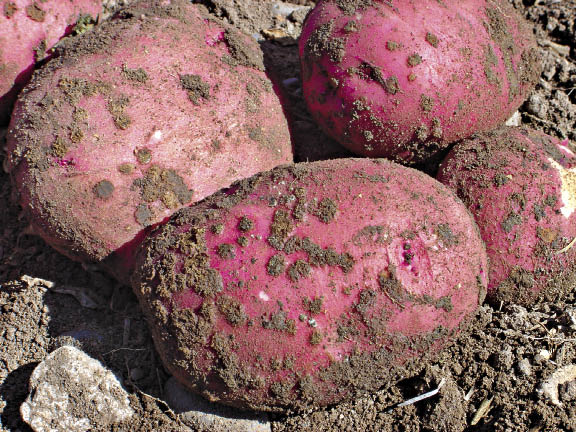 Powdery scab disease of potatoes caused by the pathogen Spongospora subterranean has become more of an issue in many potato-growing regions in the U.S. and Canada in recent years. Powdery scab causes major grading defects if tuber symptoms are prevalent and, ultimately, infected tubers can act as a source of inoculum when used as seed and planted into non-infested soils (Figure 1).
Powdery scab disease of potatoes caused by the pathogen Spongospora subterranean has become more of an issue in many potato-growing regions in the U.S. and Canada in recent years. Powdery scab causes major grading defects if tuber symptoms are prevalent and, ultimately, infected tubers can act as a source of inoculum when used as seed and planted into non-infested soils (Figure 1).
It is especially challenging in many of the thinner-skinned cultivars such as reds, whites, yellows and specialty types, but can even be found in russets that are generally considered more resistant to tuber symptoms. The disease is driven by environmental conditions that are favorable for disease development, both in the roots and on the tubers. Soils prone to saturation or with poor drainage are most problematic, but even good soils under the right conditions (soil temperatures in the 52-65 degrees F range with free moisture available) can have issues.
Sporeballs
However, all of this is moot without the inoculum being present in the fields. Inoculum of powdery scab consists of structures known commonly as resting spores or sporeballs. Sporeballs are units produced by the powdery scab organism that are very resistant to most environmental influences, including drying, freezing, moisture, etc., and can remain in the field for several years. Very low levels of sporeballs can cause infection in susceptible cultivars both on the roots as root lesions and root galls, and on the tubers as scabby lesions filled with powdery masses that look like dust. This dust-type material in the lesion is actually extremely high numbers of sporeballs.
Sporeballs can also be produced from the root galls. These sporeballs stay in the soil and act as inoculum for the following years' potato crops. Sporeballs are the source of the infective units known as zoospores (small, swimming bodies that infect the roots and tubers during the growing season). Each sporeball can have numerous zoospores produced when conditions are favorable.
So, one of the first and very important management control options is to find out how many sporeballs are in the field soil. Why is this important? The amount of inoculum present often dictates how bad the powdery scab infection may be. Also, growers' fields may be contaminated by sporeballs blowing in the wind or by infested seed, as mentioned earlier, which had so few lesions that the grower was unaware of the problem. It may take years for the inoculum level to increase, but after time, planting a susceptible cultivar with the right environmental conditions during the growing season can yield a big surprise at harvest.
PCR Technique
For the last several years, Colorado has been using a PCR technique developed by Qu and Christ at Penn State. With this test, the approximate number of sporeballs present in each field soil can be determined. This process is fairly straightforward and relatively accurate.
First, representative samples of the field soil must be obtained. These samples should be taken from the potato root zone (8-14 inches deep) and can be taken as a subsample of normal field soil testing for something like fertility or nematodes. Then, the gel is run and the test completed. Multiple controls representing several different levels of sporeballs are also included with each gel. In this way, the viewer can compare the density of the band as it appears on the gel. Each individual sample is compared to the controls and a level of sporeballs present per gram for each soil tested is established. If you look at the gel in Figure 2, several things are apparent. First, the density of the band (the white region under each number) tells the viewer the approximate level of sporeball material present in each sample. The thicker and more dense the band, the more sporeballs present.
Second, occasionally the controls represented by the first five numbers in the upper left quadrant of the gel (1, 10, 50, 100, 500) do not work as seen under the 50 category. However, by having multiple controls, a good estimate for each sample can still be made. Finally, when looking at the samples on the upper right zone and the entire lower zone, most of the samples demonstrate fairly low levels of sporeballs present. The two last samples, however, show levels representative of 50 or 500 sporeballs per gram of soil. The fields represented by these samples have high levels of inoculum and may be unsuitable for planting susceptible cultivars.
Experience in the San Luis Valley, Colo., indicates that as sporeball levels drop in the soil, so does the potential for powdery scab problems during the season. While we know that very low levels of sporeballs per gram of soil (less than one) can result in infection, practically speaking, sporeball loads in the range of 10-25 per gram of soil tend to generate relatively low powdery scab issues even with appropriate environmental cues. By determining the relative level of inoculum in each field, growers are able to make good, appropriate decisions on which fields to plant the most susceptible cultivars. Using this information is a big step forward in managing this disease.